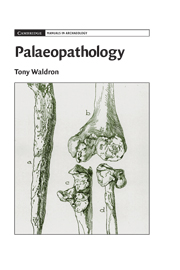Book contents
- Frontmatter
- Contents
- List of Figures
- Preface
- 1 Introduction and Diagnosis
- 2 Bone Metabolism and Pathology
- 3 Diseases of Joints, Part 1
- 4 Diseases of Joints, Part 2
- 5 Bone forming and DISH
- 6 Infectious Diseases
- 7 Metabolic Diseases
- 8 Trauma
- 9 Tumours
- 10 Disorders of Growth and Development
- 11 Soft Tissue Diseases
- 12 Dental Disease
- 13 An Introduction to Epidemiology
- Select Bibliography
- Index
- References
6 - Infectious Diseases
Published online by Cambridge University Press: 05 June 2012
- Frontmatter
- Contents
- List of Figures
- Preface
- 1 Introduction and Diagnosis
- 2 Bone Metabolism and Pathology
- 3 Diseases of Joints, Part 1
- 4 Diseases of Joints, Part 2
- 5 Bone forming and DISH
- 6 Infectious Diseases
- 7 Metabolic Diseases
- 8 Trauma
- 9 Tumours
- 10 Disorders of Growth and Development
- 11 Soft Tissue Diseases
- 12 Dental Disease
- 13 An Introduction to Epidemiology
- Select Bibliography
- Index
- References
Summary
Most experts believe that infectious diseases were common in the past and that many of the deaths of the very young seen in skeletal assemblages would have resulted from gastro-intestinal infections, as is the case in developing countries today. Almost all forms of infection spread by the faeco-oral route must have been common in the past and almost unavoidable before there was any way to separate drinking water from sewage. Unfortunately for the palaeopathologist, the infections that are likely to have accounted for the death of children leave no stigmata on the skeleton and until and unless we are able to extract bacterial or viral DNA or RNA from the bones of their victims, we will remain ignorant of if, and how often, infectious diseases might have caused death.
Those living in tropical climates would have almost certainly died from malaria and other tropical infections, probably at no less a rate than at present, while at various times the plague, smallpox and cholera all accounted for terrible, episodic periods of mortality in tropical and non-tropical climes. For most infections to be sustained, a large population is required and so the acute bacterial and viral infections are not likely to have assumed significant threats to life on a large scale before populations became settled and grew in numbers. For the hunter gatherers, and other nomadic peoples, the main burden of infectious diseases would have been from parasites living in the gut, which survive for long periods in their hosts and reproduce asexually in situ or lay eggs that can be picked up from the environment by uninfected hosts.
Information
- Type
- Chapter
- Information
- Palaeopathology , pp. 83 - 117Publisher: Cambridge University PressPrint publication year: 2008
